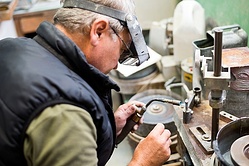I was recently interviewed by my friend, Justin Zawaly, COO of TalMetrix about innovation & employee engagement…as Justin states, “One of the outcomes of an engaged culture is innovation. Innovation doesn’t just happen, or at least it cannot be sustained, unless both the employer and employee are thriving. Innovation becomes part of organizations culture and must be measured and monitored like anything else to ensure the creative vision is being nurtured.”
Check out our interview below:
What does the term ‘innovation’ really mean?
Something that’s meaningfully unique. Unique in that it’s uncommon, unexpected, a wow or dramatically different than any other option. Meaningful in that it makes sense in your customer’s life. It improves something. It adds value.
Interestingly, so many of us over complicate this term. Others oversimplify. But in every case there’s something that holds true in everyone’s definition in a company – and that’s that they’re all different! One of the most common sources of misalignment on innovation is a common definition of innovation. And if I don’t know what we “count” as innovation, then how can I hope to know when I’m working towards it.
Why don’t more companies innovate?
In our 30 year history it’s been an interesting journey watching the relationship of innovation and companies evolve. Before the 2000s we had to spend serious time and energy just educating business leaders why innovation was a critical business building skill. Even when the bottom fell  out of the economy in the early 2000s businesses continued to think, “We’ll just take a temporary price cut. When the economy comes back we’ll pop right back up.” When that didn’t happen, they started to think very differently.
out of the economy in the early 2000s businesses continued to think, “We’ll just take a temporary price cut. When the economy comes back we’ll pop right back up.” When that didn’t happen, they started to think very differently.
But, even though the case for innovation has been made clear in business case after case, through journal article and white papers, one thing remains. The reality of innovation is that it creates change. Change creates chaos. And chaos creates fear. And it’s that fear of the unknown that keeps companies doing what they’re comfortable with versus really innovating.
Isn’t innovation just getting the “big idea”?
There’s a fantastic video of Steve Jobs talking about innovation that just hits this squarely on the head.
Jobs says, “One of the things that really hurt Apple was right after I left John Scully got a very serious disease. And that disease – I’ve seen other people get it too. It’s the disease of thinking that a really great idea is 90% of the work. And if you just tell all these other people, ‘Here’s this great idea.’ Then of course they can go off and make it happen.
And the problem with that is, there’s just a tremendous amount of craftsmanship in between a great idea and a great product. And as you evolve that great idea it changes and grows. It never comes out as it starts. Because you learn a lot more as you get into the subtleties of it and you also find there’s tremendous  trade offs you have to make. There are certain things you can’t make electrons do, or glass do, or plastic do, or factories.
trade offs you have to make. There are certain things you can’t make electrons do, or glass do, or plastic do, or factories.
And as you get into all these things…designing a product is about keeping 5,000 things in your brain…these concepts…and fitting them all together and continuing to push and put them together in new and different ways to get what you want. And every day you discover something new that’s a new problem or opportunity to fit these things together a little differently. And it’s that process that is the magic.”
Net, the answer is “No.” Innovation is not the big idea hunt. Innovation only counts when you ship – and that means having an innovative mindset, skills, and agility all the way from the initial inspiration through to making it a reality.
Where does culture play a role in innovation?
Culture plays a huge role in a company’s innovation performance. It’s the right-brained side of the 2-sided innovation coin. One side measures a company’s financial performance on innovation. But in order to see if that’s sustainable you have to measure their systems and culture for keeping at that innovative way of working. Because any company can get lucky. They can force an innovation around their broken internal systems and ship. But unless they have a good system and culture, the work around will be a well worn path of frustration.
All too often I see companies try to work these parts separately. They’ll invite in clever speakers to make the culture better. They’ll even give employees an “innovation day” once a month or quarter. Then they’ll also measure the financial progress of their innovations and pipeline of innovations. Then I’ll hear frustration when the financial performance isn’t there.
Therein lies the problem. The work and the culture are seen as separate. They are not. You change employees perspectives by changing how they work. You make innovation a fabric of their day and their job, rather than a line item on an employee review.
What is the criticality of measuring whether an innovative culture is taking hold?
The interesting question is not just measuring the culture, but what action you’ll take because of that measurement.
Dr. W. Edwards Deming, noted statistician and “father” of the quality movement (think: Lean, Six Sigma, Total Quality) had an interesting perspective here. Deming was an incredible advocate for the worker, having espoused the famous quote, “94% of the problem is the system. 6% is the worker.” Essentially, he believed no employee got out of the car in the morning, put two feet on the ground and thought, “I really want to do crappy work today.” He believed that every person strives to do good work. But the question is, “Have we given them the systems to be successful?” Or, in this case, “Have we made it possible, practical, and easy to innovate?”
Deming lived by control charts and measurement. However, often employee measures were used to blame the worker, rather than recognize that most problems were due to poor systems.
With that in mind, in our view measurement of the perception of the culture by employees is essential for helping you know whether or not you are moving the needle. It is a complimentary measure to that of the value of the pipeline of innovations they’re working on. But what’s important is understanding that the opportunity for improvement of those measures lies not in scrutinizing the employees, but fixing the root issue – the system of innovation or lack thereof.
How do you actually change the culture of organization to make them more innovative?
I’m working with an organization right now that’s making steady strides here. They had an extensive assessment done to recognize that they significantly lacked a culture of innovation, and it showed in their continued loss of revenue each year.
They did 2 major things to change the culture.
- They changed their philosophy on innovation from a “nice to do” to a “must do.” And they focused on specific strategies to drive their revenue with innovation – because that was their most urgent issue.
- They invested in systems to make their people successful with innovation. They made it easy for them to collaborate, instead of giving lip service to the word. They created real systems for experimentation and getting fast feedback, so they could make decisions faster. They gave them a work process for how to innovate. And most importantly, they taught everyone how to innovate.
Now, when you ask an employee about innovation they’ll tell you, “I used to not have time for innovation. I was too busy. Now it’s so built in, it’s just how I work.”
When you can get to a level that the innovation culture is so transparent that it’s “just the way you work,” then you can rest assured that your staff is excited, they’re working on new things and you’ll see it’s effects on the bottom line.

